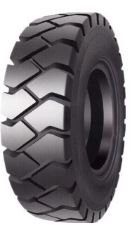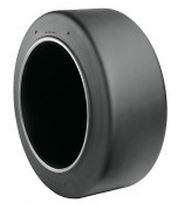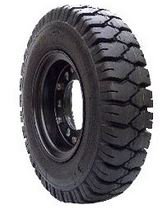Archive for May, 2024
Drive and Load Wheel Solutions for Warehouse Products
The three common enemies of drive-and-load wheels for warehouse products like Reach Trucks, Order Pickers, and Pallet Jacks are heat, debris, and poor floor conditions. Here’s what you need to know about these enemies in order to decide on the best solution and overcome them in your unique operation.
Heat
Compression in these types of wheels creates heat. As the wheel rotates, the portion contacting the floor is compressed, and then when that part is no longer touching the floor, it expands back to its original shape. You can see an example of this by looking at the tires on your car. This expansion and contraction create heat. If this heat builds up enough, it creates cracks in the load wheel compound or causes the bond between the wheel compound and the wheel hub to release. As surprising as it may seem, this heat buildup even occurs in freezer applications.
Higher durometer compounds are the most common way to battle the heat. A higher durometer number means the wheel is “harder,” so it resists compression. Less compression equates to less heat. Trucks that move constantly generate more heat in the wheels, so they benefit from higher durometer wheels. The trade-off is that harder wheels have a rougher ride and usually cost more to purchase. The diameter of the wheel also plays a part in this heat equation. Larger-diameter wheels do not have to spin as fast as smaller-diameter wheels, so the compression cycle does not happen as often in a given distance. This is why drive tires can outlast load wheels on a given truck, even if they are the same compound.
Debris And Poor Floor Conditions
Debris exists in many customer operations as a by-product of the work environment. It may be due to poor housekeeping or due to a process that generates a lot of debris in the area where operators drive; but it is a load wheel killer. While debris can shorten the life of any forklift tire, load wheels tend to suffer the most.
Good housekeeping practices are the best form of eliminating load wheel damage from debris. Debris, such as a piece of pallet stringer or a rock from the outdoor yard, can keep the load wheel from turning. In the case of a forklift or pallet jack, though, there is a drive motor strong enough to keep the equipment moving while that load wheel slides along the floor. This creates a flat spot on the load wheel. If the debris is small enough for the load wheel to roll over, the heavy load on the forks often presses the debris into the load wheel material. Eventually, there isn’t enough space for both the debris and the load wheel compound, forcing the load wheel to come apart.
Good housekeeping is essential because even the smallest debris can seriously damage your wheels — regardless of its brand name or durometer.
Load Wheels
Load wheels are one of the most often overlooked aspects of warehousing products that can cause headaches when not configured correctly. The standard load wheel is frequently selected, assuming that it is a “one size fits all” solution. Understanding and using the correct load wheel for the application can significantly reduce your downtime and increase your productivity.
Reach Trucks
As mentioned before, heat and debris are enemies of drive and load wheels. Reach trucks have the unique opportunity to increase the diameter of the load wheel. This reduces heat by reducing the number of rotations the wheel has to make over a given distance. The increased diameter also allows the wheel to roll over debris more easily, reducing or eliminating the cause of flat spots. On the Toyota Reach Truck, there is an option for a 10-inch tall load wheel to accomplish this solution. Keep in mind that with such tall load wheels, you will need either wider baselegs to straddle the load or lift the loads up and over the load wheels to keep the pallets from coming in contact with them.
Pallet Trucks
One type of wear unique to pallet trucks is “coning.” This is when the load wheels wear into a cone shape, usually with the edge closest to the outsides of the forks being the most worn. Frequent, tight turns can cause coning. This is especially noticeable when the floor surface is more abrasive. The best way to combat coning is to use load wheels that have been split into sections. This allows the outer portion of the load wheel to spin faster than the inner portion during a turn. This reduces the scuffing that causes cone-shaped wear. This is available as a triple load wheel on the Toyota Center-Controlled Rider, End-Controlled Rider, and Large Electric Walkie Pallet Jack. The Toyota Electric Walkie Pallet Jack is available as a dual-load wheel.
Stand-Up Counterbalance Trucks
These trucks do not have load wheels. They are included in this list because the steer wheels on these models can suffer from the same heat effects as load wheels do. On a Stand-Up Rider Forklift, the steer wheels carry a heavy counterweight when there is no load on the forks to counterbalance. Customers who have light loads or frequent trips across the warehouse with empty forks can experience the same type of heat-related failures as a reach truck customer with load wheels. For this reason, the Stand-Up Counterbalance has steer wheel compounds ranging from soft rubber to hard polyurethane. The hard polyurethane tire will have a rougher ride but will not heat up as easily in applications that do a lot of driving with little to no weight on the forks.
Drive Wheels
Drive wheels (aka Drive Tires) deal with similar heat and debris issues as load wheels, with the addition of needing to provide traction for acceleration, braking, and steering. When needing to find the best fit for an application, this makes the trade-off into a three-way consideration, instead of the two-way consideration of the load wheel. Generally speaking, traction takes priority of the three factors. Floor conditions will play a big role in determining how much of a priority traction takes.
Drive wheels may have to function on smooth floors with moisture or dust, making traction difficult. The floor may be abrasive, providing high traction but also increasing wear on the tire. There may be ice on the floor, but in a food environment where a metal-studded tire would not be acceptable. In order to provide the best possible solution for the customer, a variety of drive tires are offered. The list below describes a few of the available options, but there are more types available through factory installation and aftermarket sales.
Drive Wheel Type
Rubber Wheels
Pros: Smooth ride, good traction on a variety of floors.
Cons: Soft compound means easier heat buildup in applications that are always moving.
Smooth Polyurethane Wheels (Varying Durometers And Compounds)
Pros: Non-marking, various compounds allow for a customized balance of ride quality vs heat resistance.
Cons: Requires better floor conditions for traction. Smooth, dry floors or mildly abrasive floors are best.
Siped-Polyurethane Wheels (Smooth Polyurethane Tire That Has Diagonal Razor Cuts In The Traction Surface)
Pros: Provides better traction in slippery conditions than a smooth poly tire while retaining heat resistance benefits.
Cons: Razor cuts in the poly material reduce the tire’s life if driven on a dry or abrasive floor. Potential reduction in traction on smooth, dry floors due to reduced surface area.
Selecting the right tire compound for your forklift and application doesn’t need to be a hassle. A free site consultation from Toyota Material Handling Solutions can help to confirm the tire type and size that best fits your specific needs. If your current tire setup is less than optimal, we can also help you order replacement load wheels and drive wheels to get you back on track and work as productively and efficiently as possible.
The original content is located here.
Subscribe to Toyota Forklift’s blog here.
What Forklift Tires & Options Do I Need?
Toyota provides a variety of options for your forklift. Depending on your specific application, some options may provide additional safety benefits for your workplace.
Tire Options
Forklift tires are available in three types: Cushion, Solid Pneumatic, and Air Pneumatic.
1. Cushion Tires are composed of solid rubber and are directly pressed onto the wheel. They sit lower to the ground and offer a smaller turning radius, which provides an advantage in maneuverability. Cushion Tires are primarily suited for indoor or paved applications as they can struggle on uneven surfaces like gravel.

2. Pneumatic Tires (Solid) are designed of solid rubber, much like a cushion tire and are the most common tire on the market today. Solid pneumatic tires are commonly used for a combination of indoor and outdoor applications. However, solid pneumatic tires do not offer the same comfortable ride a cushion tire does across paved surfaces. The initial investment is higher, but they are practically indestructible and have a very long life.
3. Pneumatic Tires (Air Filled) are designed of rubber, but are air filled much like a car or truck tire. They have a deep tread and are made of strong, long-lasting rubber material. These tires are better for rough outdoor terrain.
Although tires are an important component to the operation of the forklift, other options must be reviewed and considered before you make your purchase.
Application-Based Components
- Back-up alarms offer a clear warning to pedestrians when the operator is operating the forklift in reverse.
- Flashing Lights/Strobes/Rotating Beacons assist the operator in alerting pedestrians to the presence of the forklift.
- Mirrors offer extended visibility for the operator
Ergonomics
Ergonomics may seem like a luxury, but for an employee who spends their day on a forklift, adjustable seats, and comforts can reduce the risk of stress injuries and make for a more productive day.
Attachments
- Side shifters enable the operator to move the load left and right without moving the forklift. This allows the operator to place the load exactly where they require it.
- Side shifting Fork Positioner enables the fork spread to be adjusted from the driver’s seat eliminating the need to manually adjust the forks.
A wide variety of options are available for your forklift. Contact us to learn more and help determine which options will work best for your application.
The original content is located here.
Subscribe to Toyota Forklift’s blog here.
What you need to know about forklift tires
When selecting forklift tires, it’s crucial to consider your application, forklift model, and work environment. Various applications call for different forklifts and, consequently, different tire types. Read our blog post to discover answers to frequently asked questions about forklift tires and applications.
How do I choose the right forklift tires?
Your forklift’s wheels and frame are typically designed for a specific tire type, such as pneumatic or cushion tires. To ensure compatibility, consult your local dealer and the forklift’s manual.
Is it possible to switch forklift tires to a different type?
While it’s often possible to switch between similar tire types (e.g., smooth cushion to traction cushion or pneumatic to solid pneumatic), transitioning between cushion and pneumatic tires is rare.
When replacing tires, it’s important to ensure consistency on both sides of the forklift. While the front and back tires can differ, both front tires and back tires must be the same type. For instance, having a mix of smooth cushion and traction cushion tires on the same axle isn’t recommended; instead, opt for uniformity, such as two smooth cushion tires in the front and two traction cushion tires in the back.
What forklift tire is best for factory or indoor applications?
Cushion tires are ideal for indoor settings with clean floor surfaces. They offer longevity, enhanced maneuverability, and improved traction.
What type of forklift tire should we use outdoors in rough terrain?
Outdoor and rough terrain environments benefit from pneumatic or solid pneumatic tires to provide traction and stability on uneven surfaces.
What forklift tire is best for general warehousing and warehouse applications?
Warehousing tasks, especially those involving order pickers, often require polyurethane tires. These tires enhance stability and traction on warehouse floors.
What type of forklift tire should we use in a cold storage environment?
In cold or wet environments, polyurethane tires with microgrids or razor sipes are typically used for better traction and braking, especially in slick conditions.
What type of forklift is best for food storage or other sensitive applications?
Sensitive industries like food, paper, or printing often need non-marking tires to avoid cross-contamination issues caused by carbon black particles present in standard tires.
If you need assistance choosing or replacing your forklift tires, our material handling professionals can help. Contact us today to set up a free consultation with a forklift tire expert.
Want to upgrade your forklift with new tires at unbeatable prices? We have front and rear options available in cushion and pneumatic styles. Shop our tire sale now. The promotion ends June 30, 2024.
Why You Should Care About Forklift Tires
Forklift tires play a crucial role in forklift operations’ performance, efficiency, and safety. Here are six reasons why forklift tires are so essential:
Traction
Forklifts often operate in environments with various surfaces, including smooth warehouse floors, outdoor pavement, gravel, or even icy conditions. The right tires provide adequate traction, allowing the forklift to grip the ground securely and maneuver safely, especially when carrying heavy loads.
Stability
Forklifts carry substantial weight in the form of the loads they transport and their machinery. Properly selected tires contribute to the forklift’s stability, preventing tipping or sliding, which is crucial for the safety of operators and nearby personnel.
Load Handling
Different tire types suit various load capacities and handling requirements. Pneumatic tires are ideal for outdoor use and rough terrain, while cushion tires are better suited for indoor operations on smooth surfaces. Choosing the right tires ensures optimal load-handling capabilities and minimizes the risk of accidents.
Durability and Longevity
Forklift tires get a lot of use, resulting in heavy wear and tear in demanding industrial environments. Durable tires can withstand the rigors of daily use, reducing the frequency of replacements and maintenance downtime, thus contributing to overall operational efficiency and cost savings.
Operator Comfort
Forklift operators spend long hours behind the wheel, often navigating challenging terrain. Tires with appropriate cushioning and shock absorption properties provide a smoother ride, reducing operator fatigue and improving productivity.
Environmental Considerations
Forklift tires can impact environmental factors such as noise levels and emissions. Choosing eco-friendly tire options, such as electric forklifts with non-marking tires, can help minimize the carbon footprint and comply with workplace regulations.
In essence, forklift tires are not just rubber components; they are critical elements that directly influence forklift operations’ performance, safety, and efficiency. Investing in the right tires tailored to the specific needs of your workplace environment is essential for optimizing productivity and ensuring a secure working environment.
If you need help selecting or replacing your forklift tires, our team of material handling experts is here to assist you. Reach out today to schedule a complimentary consultation with one of our forklift tire specialists.
Want to upgrade your forklift with new tires at unbeatable prices? We have front and rear options available in cushion and pneumatic styles. Shop our tire sale now. The offer ends on June 30, 2024.



